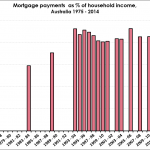Too many cookies in the education jar

Much is being said of the government’s support of private over public education of late. Last week was accentuated by the Private school, public cost report suggesting private funding will soon overtake public, with other opinion pieces echoing its sentiments.
According to the research based on MySchool data, Government support for private school is growing at twice the rate of public schools’ support. This, however, is only true if you focus on the last 6 years. The complete opposite trend was true for the 5 years prior. While MySchool data is only available since 2009, the Productivity Commission’s Report on Government Services goes further back and shows a different trend over an extended timeline¹.
 The report’s major strength is that it compares a finer slice of the community, focusing on schools with similar socio-economic backgrounds. This removes the effect of funding allocations based on need, which the government currently follows. Seeing as public schools disproportionately service poorer areas, using PC’s rough average (as I did) overestimates the difference in funding as the population serviced by private schools is generally cheaper to support. Unfortunately, the complete MySchool data is not easily available online, so my analysis is restricted to aggregate data and misses this finer level investigation.
The report’s major strength is that it compares a finer slice of the community, focusing on schools with similar socio-economic backgrounds. This removes the effect of funding allocations based on need, which the government currently follows. Seeing as public schools disproportionately service poorer areas, using PC’s rough average (as I did) overestimates the difference in funding as the population serviced by private schools is generally cheaper to support. Unfortunately, the complete MySchool data is not easily available online, so my analysis is restricted to aggregate data and misses this finer level investigation.
However, while I suspect the difference is smaller than that suggested by the PC analysis above, the trend over the 11 years is likely to be the same.
Surprisingly, it’s not only Federal Governments whose support increased faster for private schools over the past 6 years. State Governments increased private schools funding at 2.6 times the public schools’ rate between 2009 and 2014, with all but NSW and SA increasing support for private faster than for public over that period. Northern Territory’s private school support grew at almost twice the rate of their public school support.

Growth in Federal Government’s support has been relatively even over the same period, with private schools funding growing 18% faster than public.

(N.B.: All analysis is conducted on figures adjusted for inflation.)
The main reason for private schools outpacing public schools is that Federal Govs have increased school funding faster than State Govs. Over the 6 years in question, State Government funding on average increased by a miserly 4%, while Federal Governments increased education support by 25%. As Federal support private education more than they do public (as a base rule), their increase ends up largely in private coffers. Even if Federal grants increased equally across both sectors of education, private schools would win.
This does not excuse the recent growing support for private school funding, but suggests that perhaps our current funding models are too complex and compartmentalised to understand how each lever impacts individuals and/or the entire system. We have too many jars, and too many types of cookies in them. Whether on purpose or misfortune, this often leads to undesired results, like the examples mentioned in the Private school, public cost report, where some private schools receive more funding than their neighbouring public educators.
As long as private schooling is legal, governments need to ensure they are adequately funded and this means continue funding for private education. However, the upper echelons of private education should not be taking resources away from those who need it most.
Education policies should be about more than funding, i.e. how the funding will be used, but perhaps there is room for one overarching policy, not about how much funding will be allocated, but how the cookie factory will be better and more equitably managed
[1] Following “Private school, public cost” methodology, public funding is multiplied by 0.85 to remove User Cost of Capital.
















